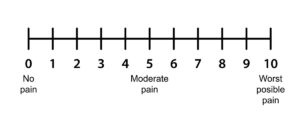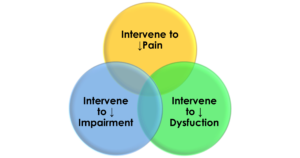Pain – Movement

If pain occurs with movement, then observation and analysis of movement is required.
The measurement of the symptom of pain occurs using the familiar numeric pain scale (zero to 10).

0-10 Numeric pain scale diagram. Clipart image
In 1996 the American Pain Society lead a campaign to consider the measurement of pain as the 5th vital sign. The 5th vital sign became a requirement of proper patient care as important as the basic assessment and management of temperature, blood pressure, heart rate, and respiratory rate.
It has been suggested that an unintended consequence of requiring the use of a unidimensional numerical pain scale was one of the contributing factor to the overprescribing of opioid pain medication and the resulting epidemic of drug abuse.
Notwithstanding the unidimensional numeric pain score is not the best measure of the symptom of pain it continues to be expected in medical record documentation.
Pain is an unpleasant sensory and emotional experience associated with actual or potential tissue damage or described in terms of such damage. Pain has multiple dimensions including physical, sensory, behavioral, sociocultural, cognitive, affective, and spiritual. The physical dimension of pain has multiple dimensions including the location, nature/character, temporal pattern, intensity, and rest/movement.
The numeric pain intensity scale only measures only one dimension of pain.
Shortcomings of numeric pain rating
Without more contextual information knowing the intensity of pain provides little insight.
As a patient with rheumatoid arthritis I experience periods of musculoskeletal pain. It often annoys me when healthcare providers ask, “Rate your pain from zero to 10”. They ask me when I am sitting and resting. My pain happens when I do specific activities. Pain occurs when I move. The intensity of pain varies according to how I move. My concerns are the pain is interfering with my ability to take care of myself and others, and function.
In a survey of arthritic patients, 60% thought using a numeric pain score was not an effective way to measure their pain. A study by K. Neustadi and colleagues concluded that pain is a relevant measure but not always the primary concern of the patient.
As a Physical Therapist, I find it frustrating with the regulatory requirements from corporations, and health insurance companies requiring the documentation of an unaccompanied numeric pain score.
As a Physical Therapist knowing the patient’s intensity of pain does not help me come up with a diagnosis. Knowing an unaccompanied numeric pain score does not help me adjust intervention.
The numeric pain score is subjective. An individual’s perception of pain is different from one person to another. Often as a clinician, I am skeptical of the initial information a patient provides regarding their pain. Individuals may situationally over-rate or under-rate their pain leading to over or under-treatment of pain. Additional information regarding observing movements can facilitate the clinician's assessment of whether the self-report numeric pain score is an underestimate or overestimate on the part of the patient.
The assumption is there is a direct relationship between pain and function. Test this assumption by gathering data about pain during movement during functional activity.

Movement: For the patient in pain
Pain is frequently assessed during periods of rest. But seldom during periods of activity or movement.
If you are a patient, when a healthcare professional is assessing your musculoskeletal pain share the impact of the pain has on your movements, functions, and activities.
Share:
- What the pain/discomfort keeps you from doing.
- What do you do despite the pain/discomfort?
- What you avoid doing or do less because of the pain/discomfort.
- What are you able to do at a less-than-optimal performance level because of the pain?
Below is a modification of the standard zero to 10 numeric pain scale to include a self-reported pain intensity with functional limitations measures. This is a modification of the Defense & Veterans Pain Rating Scale which uses 10 points versus the 5 levels as below.
| Pain Intensity Level | Category | Pain-Related Functional Limitations | Intervention adjustments |
| 0 | No Pain | Able to perform all my normal daily activities | Green light - Eligible to progress exercise/activity – Push & Build |
| 1 to 3 | Mild Pain | Able to perform all my normal daily activities but I experience pain | Green light - Eligible to progress exercise/activity – Push & Build |
| 4 to 6 | Moderate Pain | Able to perform some but not all my normal daily activities due to pain | Yellow light proceed with caution - Stay with same amount of activity/exercise – On the Fence |
| 7 to 9 | Severe Pain | Unable to perform most of my normal daily activities due to pain. Individuals with severe pain (7-9 range) would require partial assistance from another person to perform most normal daily activities including self-care. | Red light – Stop regress the amount of exercise activity – Rest & protect |
| 10 | Extreme Pain | Unable to perform any of my normal daily activities due to pain. Individuals with extreme pain (10) would require complete assistance from another person for all activities of daily living. | Red light – Stop regress the amount of exercise activity – Rest & protect |
Using this pain with function score provides guidance to adjust exercise and activity going forward. More details regarding how to use this information to adjust exercise activity is available here, and here.
Movement: For the clinician: treating pain
It is important to measure the impact of pain on function, and during movement rather than at rest. If pain occurs with movement, then observation and analysis of movement is required. Stress tests are common procedures for cardiac problems and financial institutions. This concept of stress testing can occur by assessing movement-evoked pain. Movement-evoked pain can be observed during standardized movement tasks that can be individualized and tailored to the individual. When a numeric pain score is combined with movement testing in a symptom modification procedure it can be a powerful diagnostic and treatment tool
A on-demand video webinar exploring this topic is available at Plus by Physiopedia entitled “Indications, Benefits, & Barriers of 2D Motion Analysis”
Use this code – “Damien25” for a 30% discount to access this webinar as well as the more than 500 continuing education webinar courses available at Plus by Physiopedia. This is the link http://bit.ly/DAMIEN30 with the 30% discount code embedded.
The information on this website is not intended or implied to be a substitute for professional medical advice, diagnosis, or treatment. You are encouraged to perform additional research regarding any information contained available through this website with other sources and consult with your physician.
Damien Howell Physical Therapy – 804-647-9499 – Fax: 866-879-8591 At-Home, At Office, At Fitness Facility – I come to you, I do home visits Damien@damienhowellpt.com

